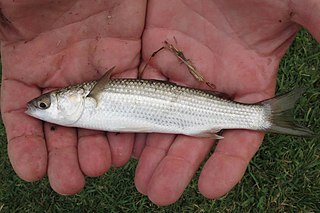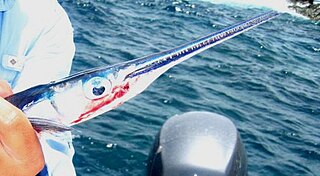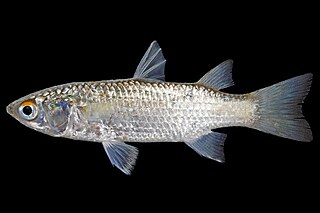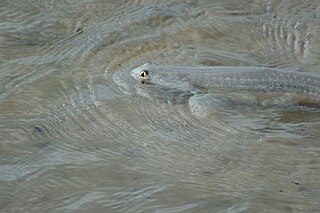
The mullets or grey mullets are a family (Mugilidae) of ray-finned fish found worldwide in coastal temperate and tropical waters, and some species in fresh water. Mullets have served as an important source of food in Mediterranean Europe since Roman times. The family includes about 78 species in 26 genera.

Agonostomus is a genus of ray-finned fish in the family Mugilidae, the mullets. Considered to be the most primitive of the mullets, they are generally marine fish. The two members of the genus occur in the Indian Ocean.
Chelon is a genus of mullets found in coastal marine waters, estuaries and rivers in the Atlantic Ocean and Arabian Sea.

Crenimugil is a genus of mullets found in coastal marine waters and rivers in the Indo-Pacific region.

Mugil is a genus of mullet in the family Mugilidae found worldwide in tropical and temperate coastal marine waters, but also entering estuaries and rivers.

The sand grey mullet is a species of mullet found in coastal marine waters of Australia.
The Otomebora mullet, the giantscale mullet or St. Lucia mullet, is a species of ray-finned fish in the family Mugilidae. It is found in the Indo-Pacific Region.

The freshwater mullet is a species of ray-finned fish in the family Mugilidae. It is endemic to South Africa.

The flat needlefish, or barred longtom, the only known member of the genus Ablennes, is a marine fish of the family Belonidae. Flat needlefish are considered gamefish, frequently caught with the help of artificial lights, but are not often eaten because of their green-colored flesh.

The mirrorwing flyingfish is a flying fish of the family Exocoetidae. It was first described by the French zoologist, Achille Valenciennes in a 22-volume work titled Histoire naturelle des poissons, which was a collaboration with Georges Cuvier.

The so-iuy mullet, also known as the haarder, redlip mullet or so-iny mullet, is a species of ray-finned fish in the family Mugilidae.

The largescale mullet is a species of ray-finned fish in the family Mugilidae. It is found in the Indo-Pacific.
The diamond mullet, is a species of mullet and is also known as the Ord River mullet. This species lives in both brackish or freshwater. Adult fish are found in estuaries, coastal waters and in some cases, ascending rivers into fresh water.
Chelon bispinosus is a ray-finned fish of the family Mugilidae. It is one of seven species in the genus Chelon. It is endemic to waters near Cape Verde in the east central Atlantic Ocean. This species is found in the neritic zone.

Planiliza is a genus of mullets found in coastal marine waters, estuaries and rivers in the Indo-Pacific.

Planiliza carinata, the keeled mullet, is a species of grey mullet from the family Mugilidae which is found in the western Indian Ocean and eastern Mediterranean Sea. It colonised the Mediterranean by Lessepsian migration from the Red Sea through the Suez Canal. The keeled mullet is a species of minor importance in commercial fisheries.

The flat-tail mullet is a species of grey mullet from the family Mugilidae. It is endemic to southern Australia where it forms schools in shallows, and lower estuaries, as well as in more saline lagoons. It spawns at sea but juveniles move into freshwater until they are a year old. It feeds on benthic microorganisms such as crustaceans and filamentous algae. It is caught as a food fish. It is the only species in the monospecific genus Gracimugil.

The corsula is a species of ray-finned fish from the mullet family Mugilidae. It is found in the rivers and estuaries of southern Asia, in India, Bangladesh, Nepal and Myanmar. It is presently regarded as the only species in the monospecific genus Rhinomugil.

The shark mullet, also known as the sharp-nosed mullet, popeye mullet, or skipjack mullet, is a species of ray-finned fish from the grey mullet family Mugilidae. It is found in Australia and New Guinea where it occurs in muddy freshwater habitats and mangroves, it feeds on algae and insects taken from the surface but also on benthic invertebrates. It can breathe air and sometimes moves over exposed mud by wriggling. It was formerly classified in the genus Rhinomugil, with the corsula, but is now placed in its own monospecific genus, Squalomugil.

The Burmese mullet is a species of freshwater ray-finned fish, a mullet belonging to the family Mugilidae. It is the only species in the genus Sicamugil. It is found in the drainage systems of the Sittang and Irrawaddy rivers in Myanmar.















